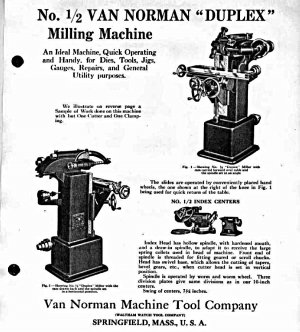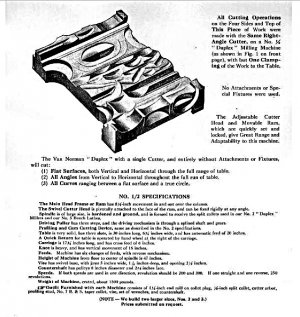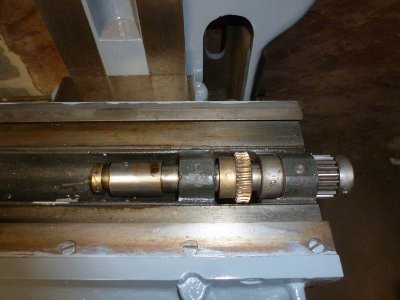-
Welcome back Guest! Did you know you can mentor other members here at H-M? If not, please check out our Relaunch of Hobby Machinist Mentoring Program!
You are using an out of date browser. It may not display this or other websites correctly.
You should upgrade or use an alternative browser.
You should upgrade or use an alternative browser.
Now Here's A "diamond In The Rough" Project!
- Thread starter Paul_NJ
- Start date
- Joined
- Sep 3, 2011
- Messages
- 478
Hi Paul,
Thanks for posting the brochure. I don't think that I've seen that before.
"B" is the part with the bull wheel. I suspect that I mounts on the right side of the base or column, directly below "D", with the two stepped pulleys lined up (large-to-small and small-to-large), bull wheel facing to the rear. Are there tapped holes in the base or column for "B" and "D"?
Thanks for posting the brochure. I don't think that I've seen that before.
"B" is the part with the bull wheel. I suspect that I mounts on the right side of the base or column, directly below "D", with the two stepped pulleys lined up (large-to-small and small-to-large), bull wheel facing to the rear. Are there tapped holes in the base or column for "B" and "D"?
Any experience in removing the stepped pulleys from the shaft in the upper drive bracket (into which the VN cutter head "drive shaft" slides)? The outer pulley came off easily when I removed it's setscrew, and there is a large setscrew in the inner pulley which I removed, but even (gently) using my hydraulic press I can't budge the inner pulley on the shaft (or turn it on the shaft for that matter). Is there another "hidden" set screw somewhere I'm missing? I tried pushing both ways in case there is a step in the shaft . . .
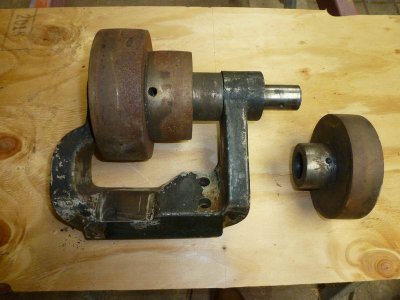
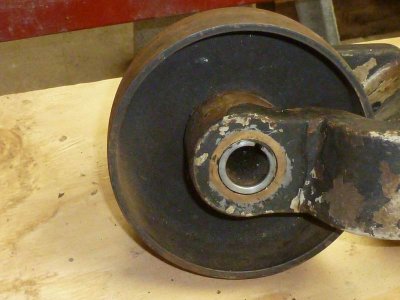
Also, there is a keyway in one end of the pulley shaft (about 1 1/2 inches long), and a matching keyway along the entire length of the head drive shaft that slides into the pulley shaft. I received all this apart, so I've never seen it assembled. Is there a long key that slides in to link the two keyways?
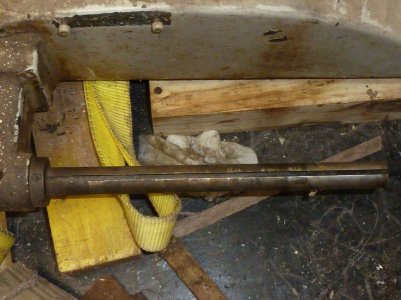
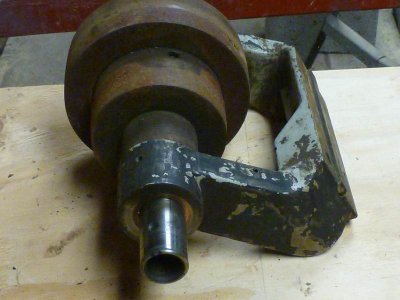
The smallest step is an idler/spacer that turns very freely on the shaft.
Don't want to use excessive force or flood everything unnecessarily with penetrating oil, if I'm missing something silly. Wouldn't be the first time . . .
Thanks
Paul


Also, there is a keyway in one end of the pulley shaft (about 1 1/2 inches long), and a matching keyway along the entire length of the head drive shaft that slides into the pulley shaft. I received all this apart, so I've never seen it assembled. Is there a long key that slides in to link the two keyways?


The smallest step is an idler/spacer that turns very freely on the shaft.
Don't want to use excessive force or flood everything unnecessarily with penetrating oil, if I'm missing something silly. Wouldn't be the first time . . .
Thanks
Paul
Last edited:
- Joined
- Nov 14, 2014
- Messages
- 851
Sometimes taper pins are hard to see through rust and paint. Your second photo in your most recent post shows the end view of a pulley. At the 10:00 o'clock position there appears to be a dimple, or indent in the surface of the bracket - tucked up towards the big end of the pulley. Is this another pin???
I have no experience with the VN assembly, but shafts are shafts, mostly. Gunk, grime, and pins are the usual suspects when a shaft won't come out. Penetrating oil in copious quantities is a good thing. Also try heating the shaft a little with a propane touch. Then flood it with penetrating oil- repeatedly over several days - if necessary. The heat will expand the metal slightly and break any residual seal around the shaft, then the oil will shrink it and draw deeper into the journal or bearing as it cools. it might just pop loose when you least expect it.
I have no experience with the VN assembly, but shafts are shafts, mostly. Gunk, grime, and pins are the usual suspects when a shaft won't come out. Penetrating oil in copious quantities is a good thing. Also try heating the shaft a little with a propane touch. Then flood it with penetrating oil- repeatedly over several days - if necessary. The heat will expand the metal slightly and break any residual seal around the shaft, then the oil will shrink it and draw deeper into the journal or bearing as it cools. it might just pop loose when you least expect it.
- Joined
- May 4, 2015
- Messages
- 3,583
If I haven't offered , I have a belt lacer or two and some of the lacing joiners. A couple pieces of belting but not much , of course if I do have your size it wouldn't be enough. No that's usually my luck. So if you need to let me know. Hell I can sell ya one if ya want.
Sometimes taper pins are hard to see through rust and paint. Your second photo in your most recent post shows the end view of a pulley. At the 10:00 o'clock position there appears to be a dimple, or indent in the surface of the bracket - tucked up towards the big end of the pulley. Is this another pin???
I have no experience with the VN assembly, but shafts are shafts, mostly. Gunk, grime, and pins are the usual suspects when a shaft won't come out. Penetrating oil in copious quantities is a good thing. Also try heating the shaft a little with a propane touch. Then flood it with penetrating oil- repeatedly over several days - if necessary. The heat will expand the metal slightly and break any residual seal around the shaft, then the oil will shrink it and draw deeper into the journal or bearing as it cools. it might just pop loose when you least expect it.
Thanks Glenn,
That indent you detected is just an oil hole in the bracket to lubricate the shaft. Anyway, the shaft turns freely in the bracket . . . it's just that I can't turn, or slide, the pulley on the shaft. I filled the setscrew hole in the pulley with Kroil and let's see if anything loosens. That pulley is a pretty large mass of steel so I'll first give it time.
Paul
Last edited:
If I haven't offered , I have a belt lacer or two and some of the lacing joiners. A couple pieces of belting but not much , of course if I do have your size it wouldn't be enough. No that's usually my luck. So if you need to let me know. Hell I can sell ya one if ya want.
Thanks Silverbullet,
My original reason for removing the shaft and pulley was, after cleaning, painting, and lubrication, eventually to find a V-belt pulley to put on the shaft. Maybe what you're suggesting is the best approach, just stick with a flat belt and leave it together. To be honest I know nothing about belts, or even what a belt lacer is. But that's still pretty far down the road on this project!
Paul
- Joined
- Nov 14, 2014
- Messages
- 851
Paul, I mentioned heating the shaft as I had a similar problem when rejuvenating my Dalton lathe earlier this year. The pulley would turn on the shaft, but would not budge off the shaft. Turns out it was rusted tightly to the shaft. The corrosion over the years formed an impenetrable barrier to the Kroil oil. Hence the heat treatment to break it free. Once the barrier was broken the Kroil was free to penetrate the shaft enuf to withdraw it.Thanks Glenn,
That indent you detected is just an oil hole in the bracket to lubricate the shaft. Anyway, the shaft turns freely in the bracket . . . it's just that I can't turn, or slide, the pulley on the shaft. I filled the setscrew hole in the pulley with Kroil and let's see if anything loosens. That pulley is a pretty large mass of steel so I'll first give it time.
Paul
Also it came out one side more freely than the other side, due to a slight misalignment with the casting- similar to driving the pulley onto a slight taper. It came loose after several days of treatment- just as I had about given up hope of freeing it!
- Joined
- Sep 3, 2011
- Messages
- 478
Paul,
It's very common to find a second set screw behind the outer one. The outer one simply acts as a plug when there are deep holes. Make some measurements to see if the set screw hole is deep enough to go to the shaft.
What type of end did the set screw have?
Make sure that you look inside the shaft to make sure that the key isn't in there. "Tit Keys", which have a pin built in, are often used to keep the key from moving on the shaft; the shaft has a hole for the pin. If not, a common key should work just fine. You may have to dress it to size.
If the saddle forms a reservoir around the gears, fill it with Mobile Vactra way oil to lubricate the gears.
It's very common to find a second set screw behind the outer one. The outer one simply acts as a plug when there are deep holes. Make some measurements to see if the set screw hole is deep enough to go to the shaft.
What type of end did the set screw have?
Make sure that you look inside the shaft to make sure that the key isn't in there. "Tit Keys", which have a pin built in, are often used to keep the key from moving on the shaft; the shaft has a hole for the pin. If not, a common key should work just fine. You may have to dress it to size.
If the saddle forms a reservoir around the gears, fill it with Mobile Vactra way oil to lubricate the gears.


